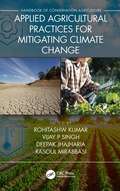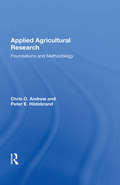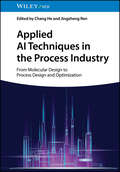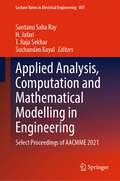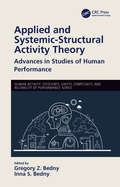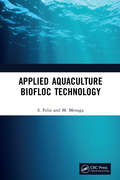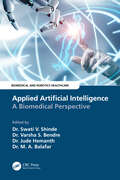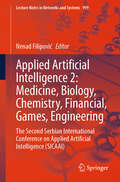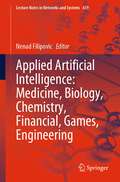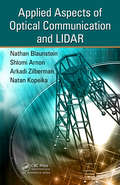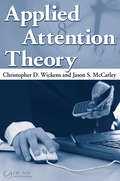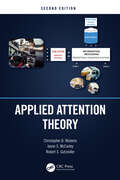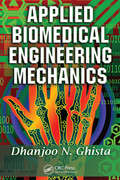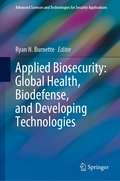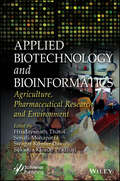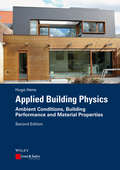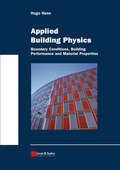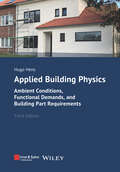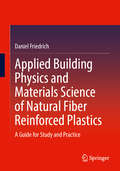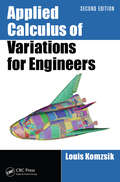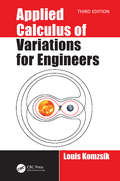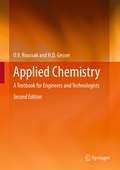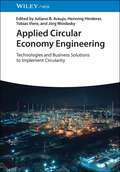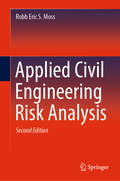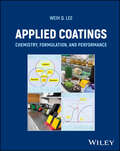- Table View
- List View
Applied Agricultural Practices for Mitigating Climate Change [Volume 2]
by Rohitashw Kumar Vijay P. Singh Deepak Jhajharia Rasoul MirabbasiConservation agriculture is a sustainable production model that not only optimizes crop yields, but also reaps economic and environmental benefits as well. The adoption of successful conservation agriculture methods has resulted in energy savings, higher organic matter content and biotic activity in soil, increased crop-water availability and thus resilience to drought, improved recharge of aquifers, less erosion, and reduced impacts from the weather associated with climate change in general. Applied Agricultural Practices for Mitigating Climate Change examines several important aspects of crop production, such as the use of microorganisms and biofertilizers as well as GIS and Remote Sensing applications. It presents the latest techniques in crop modeling, best practices for irrigation under water deficit conditions, and other approaches for sustainable conservation agriculture that consider the environmental effects of climate change. Features: Examines the effects of climate change on agriculture and the related strategies for mitigation through practical, real-world examples Explores innovative on-farm technology options to increase system efficiency resulting in improved water usage Presents examples of precision farming using climate-resilient technologies
Applied Agricultural Research: Foundations And Methodology
by Chris O AndrewThe desire to resolve problems through pragmatic observation, systematic evaluation, and coordinated action persists with each new generation of researchers. A timeless task that bears individual, social, and often cultural characteristics, problem resolution is essentially an experiential process. Routine and methodology can enhance both its proce
Applied AI Techniques in the Process Industry: From Molecular Design to Process Design and Optimization
by Chang He Jingzheng RenThorough discussion of data-driven and first principles models for energy-relevant systems and processes, approached through various in-depth case studies Applied AI Techniques in the Process Industry identifies and categorizes the various hybrid models available that integrate data-driven models for energy-relevant systems and processes with different forms of process knowledge and domain expertise. State-of-the-art techniques such as reduced-order modeling, sparse identification, and physics-informed neural networks are comprehensively summarized, along with their benefits, such as improved interpretability and predictive power. Numerous in-depth case studies regarding the covered models and methods for data-driven modeling, process optimization, and machine learning are presented, from screening high-performance ionic liquids and AI-assisted drug design to designing heat exchangers with physics-informed deep learning. Edited by two highly qualified academics and contributed to by a number of leading experts in the field, Applied AI Techniques in the Process Industry includes information on: Integration of observed data and reaction mechanisms in deep learning for designing sustainable glycolic acidMachine learning-aided rational screening of task-specific ionic liquids and AI for property modeling and solvent tailoringIntegration of incomplete prior knowledge into data-driven inferential sensor models under the variational Bayesian frameworkAI-aided high-throughput screening, optimistic design of MOF materials for adsorptive gas separation, and reduced-order modeling and optimization of cooling tower systemsSurrogate modeling for accelerating optimization of complex systems in chemical engineering Applied AI Techniques in the Process Industry is an essential reference on the subject for process, chemical, and pharmaceutical engineers seeking to improve physical interpretability in data-driven models to enable usage that scales with a system and reduce inaccuracies and mismatch issues.
Applied Analysis, Computation and Mathematical Modelling in Engineering: Select Proceedings of AACMME 2021 (Lecture Notes in Electrical Engineering #897)
by Santanu Saha Ray H. Jafari T. Raja Sekhar Suchandan KayalThis book is a compendium of the proceedings of the International Conference on Applied Analysis, Computation, and Mathematical Modelling in Engineering (AACMME-2021). The book covers a variety of applications such as mechanical, acoustical, physical, electrical, bio-mathematical, and computational fluid dynamics. Since mathematical modeling necessitates a wide range of skills and methods, the book concentrates on techniques that will be of specific interest to engineers, scientists, and those who work with discrete and continuous systems models. This book guides students, researchers, and professionals through the new approaches, the powerful tools for quickly mastering the most popular mathematical and computational models used in engineering and science. These new approaches enable readers to not only systematically create effective models, but also extend these models to any macroscopic physical structure.
Applied and Systemic-Structural Activity Theory: Advances in Studies of Human Performance (Human Activity)
by Gregory Z. Bedny Inna S. BednyThis book presents new data in Applied Activity Theory (AAT) and Systemic-Structural Activity Theory (SSAT), that can be used in the study of human performance. The SSAT is the high-level generality theory that offers standardized principles of the analyses of human activity. These principles can be utilized in theoretical and applied studies. This multi-contributed book offers a selection of works that will provide a holistic picture of the field. The new data can be utilized for the study of extremely complex human-machine and human-computer interaction systems, and for evaluation of efficiency, complexity, and reliability of such systems at the design stage. Features Shows examples of self-regulative models of various cognitive processes Illustrates a method of study of production process in the construction industry Includes topics on learning, training, and management Covers a new method of computer based automated support of decision making under risk and uncertainty Presents a new method of evaluation of probabilistic structure of tasks, and the method of assessing reliability of human performance
Applied Aquaculture Biofloc Technology
by S. Felix M. MenagaThe intent of this book is to provide a detailed and specific set of guidelines for both aquapreneurs and researchers related to the application of Biofloc Technology in aquaculture. This book discusses key issues related to both adoption and practices for aquaculture businesses, how to monitor and assess quality and quantity of biofloc, and how to manage the microbial composition and sludge reduction risk in the fish and shrimp culture. The book works through the specific application of disease management and feed management tools for aquaculture from the perspective of this technology. Particular attention is paid on comparing the prototypes of floc development and evaluation on its efficacy in aquaculture. Note: T&F does not sell or distribute the hardback in India, Pakistan, Nepal, Bhutan, Bangladesh and Sri Lanka.
Applied Artificial Intelligence: A Biomedical Perspective (Biomedical and Robotics Healthcare)
by Swati V. Shinde Varsha S. Bendre Jude Hemanth M. A. BalafarThis book explores the advancements and future challenges in biomedical application developments using breakthrough technologies like Artificial Intelligence (AI), Internet of Things (IoT), and Signal Processing. It will also contribute to biosensors and secure systems,and related research. Applied Artificial Intelligence: A Biomedical Perspective begins by detailing recent trends and challenges of applied artificial intelligence in biomedical systems.Part I of the book presents the technological background of the book in terms of applied artificial intelligence in the biomedical domain. Part II demonstrates the recent advancements in automated medical image analysis that have opened ample research opportunities in the applications of deep learning to different diseases. Part III focuses on the use of cyberphysical systems that facilitates computing anywhere by using medical IoT and biosensors and the numerous applications of this technology in the healthcare domain. Part IV describes the different signal processing applications in the healthcare domain. It also includes the prediction of some human diseases based on the inputs in signal format. Part V highlights the scope and applications of biosensors and security aspects of biomedical images.The book will be beneficial to the researchers, industry persons, faculty, and students working in biomedical applications of computer science and electronics engineering. It will also be a useful resource for teaching courses like AI/ML, medical IoT, signal processing, biomedical engineering, and medical image analysis.
Applied Artificial Intelligence 2: The Second Serbian International Conference on Applied Artificial Intelligence (SICAAI) (Lecture Notes in Networks and Systems #999)
by Nenad FilipovićThe book Applied Artificial Intelligence 2: Medicine, Biology, Chemistry, Financial, Games, Engineering is providing exceptional chapters of the state-of-the-art research knowledge and results on the innovative theories, methodology and applications of artificial intelligence and its sub-domain like deep learning, machine learning in different areas such as medicine, economy, education, law, smart city, government, industry etc. Innovative research ideas on how to solve problems using artificial intelligence, both in R&D and real-time applications are presented. Chapters describe the advanced prototypes, systems, methodologies, tools and techniques and general survey papers, which indicate future directions. These Chapters are extended papers from the Second Serbian International Conference on Applied Artificial Intelligence (SICAAI), which was held in Kragujevac, Serbia, on May 19-20, 2023
Applied Artificial Intelligence: Medicine, Biology, Chemistry, Financial, Games, Engineering (Lecture Notes in Networks and Systems #659)
by Nenad FilipovicThe book is covering knowledge and results in theory, methodology, and applications of artificial intelligence and machine learning in academia and industry. Nowadays, artificial intelligence has been used in every company where intelligence elements are embedded inside sensors, devices, machines, computers and networks. The chapters in this book integrated approach toward global exchange of information on technological advances, scientific innovations, and the effectiveness of various regulatory programs toward AI application in medicine, biology, chemistry, financial, games, law, and engineering. Readers can find AI application in industrial workplace safety, manufacturing systems, medical imaging, biomedical engineering application, different computational paradigm, COVID-19, liver tracking, drug delivery system, and cost-effectiveness analysis. Real examples from academia and industry give beyond state of the art for application of AI and ML in different areas. These chapters are extended papers from the First Serbian International Conference on Applied Artificial Intelligence (SICAAI), which was held in Kragujevac, Serbia, on May 19–20, 2022.
Applied Aspects of Optical Communication and LIDAR
by Nathan Blaunstein Shlomi Arnon Natan Kopeika Arkadi ZilbermanExploring the practical aspects of atmospheric optical communication and light detection and ranging (LIDAR), Applied Aspects of Optical Communication and LIDAR details the role of atmospheric structures in propagation phenomena that influence the transmission of optical signals through perturbed atmospheric communication channels. It examines nume
Applied Attention Theory
by Christopher D. Wickens Jason S. McCarleyEye witness testimony, training, driving, and display design: these are just a few of the real-world domains in which depend on undivided attention. Emphasizing the link between theory and application, Applied Attention Theory provides a deep understanding of how theories of attention, developed from laboratory-based psychological research, can inform our understanding of everyday human performance in a wide number of applications and environments. The basic theories discussed concern divided, focused, and selective attention, and areas of application include mental workload measurement, multi-tasking, distracted driving, complex display design, education, and the training of attentional skills. Includes an extensive reference list and citations to both basic and applied work Provides intuitive descriptions of attentional phenomena in the world beyond the laboratory Discusses applications of attention theory to diverse areas such as graph design, distracted driving, and process control Offers an engineering orientation as well as a psychological orientation to research Highlights the critical role of effort in single task behavior, such as decision and choice, to the extent that humans tend to be effort-conserving in their choice of activities Examines how multiple tasks are managed in a discrete fashion
Applied Attention Theory
by Christopher D. Wickens Jason S. McCarley Robert S. GutzwillerApplied Attention Theory, Second Edition provides details concerning the relevance of all aspects of attention to the world beyond the laboratory. Topic application areas include the design of warning systems to capture attention; attention distractions in the workplace; failures of dividing attention while driving; and the measurement of mental workload while flying. This new edition discusses the implications of VR and AR for human attention. It also covers the treatment of attention-based pedagogical methods used to enhance learning and presents attentional issues in interacting with automation and AI. New chapters include applications of attention to healthcare, education pedagogy, highway safety, and human interaction with autonomous vehicles and other AI systems. The readership for this book is the professional, the researcher, and the student.
Applied Biomedical Engineering Mechanics
by Dhanjoo GhistaPresenting the latest innovations, this text highlights advances in tissue, musculoskeletal, locomotive, orthopedic, occupational, ergonomic, sports, cardiovascular, cardiac, and pulmonary biomechanics. Based on years of teaching experience, the author uses illustrative examples and detailed explanations to show how mechanics disciplines can be applied to a wide range of clinical applications, including the analysis of physiological and organ-system processes; the creation of physiologically compatible organ-assist systems and devices; the performance of pre-surgical analysis in order to develop optimal surgical approaches; and the design of vehicle-occupant systems for occupant comfort.
Applied Biosecurity: Global Health, Biodefense, and Developing Technologies (Advanced Sciences and Technologies for Security Applications)
by Ryan N. BurnetteThis book describes an adaptable biothreat assessment process to complement overall biorisk management programs, incorporating threat management and the unique natures of biological assets. Further, this book examines the nexus between public health, international security, and developing technologies, building a case for augmenting biosecurity to levels beyond the laboratory constraints. With the face of biological and biomedical sciences changing, this book describes how with proper biosecurity development, these can become assets, rather than liabilities, to secure our world from natural and man-made biological disasters. The world is changing rapidly with respect to developing threats, such as terrorism, and dual-use technologies, such as synthetic biology, that are challenging how we think about biosafety and biosecurity. Further, the fields of public health and international security are colliding, as both of these share the common enemy: intentional or natural biological incidents. To date, biosecurity has been limited to laboratory-level application, and complicating efforts, and lacks credentialed biosecurity professionals skilled in both the biological sciences and threat management techniques. The result is a fragmented field of practice, with tremendous need, from the lab to the outbreak. Underpinning these principles is the SARS-CoV-2 coronavirus pandemic, providing a historic milestone to examine biosecurity through a global lens. This book describes biosecurity as a set of practices and principles to be augmented out of the constrained laboratory environment, and applied to larger efforts, such as international threat reduction and biological incident management.
Applied Biotechnology and Bioinformatics: Agriculture, Pharmaceutical Research and Environment
by Hrudayanath Thatoi Sonali Mohapatra Swagat Kumar Das Sukanta Kumar PradhanThis comprehensive reference book discusses the convergent and next-generation technologies for product-derived applications relevant to agriculture, pharmaceuticals, nutraceuticals, and the environment. The field of modern biotechnology is a multidisciplinary and groundbreaking area of biology that includes several cutting-edge methods due to developments in forensics and molecular modeling. Bioinformatics is a full-fledged multidisciplinary field that combines advances in computer and information technology. Numerous applications of bioinformatics—primarily in the areas of gene and protein identification, structural and functional prediction, drug development and design, folding of genes and proteins and their complexity, vaccine design, and organism identification—have contributed to the advancement of biotechnology. Biotechnology is also essential to crop improvement in agriculture because it allows genes to transfer across plants to increase traits such as disease resistance and yield. It also plays a broad role in healthcare, including genetic testing, gene therapy, pharmacogenomics, and drug development. Bioremediation and biodegradation, using microbial technologies to clean up environmental contamination, waste management technologies, and the conversion of organic waste to biofuels. Bioinformatics plays a critical role in analyzing different types of data created by high-throughput research methods—such as genomic, transcriptomic, and proteomic datasets—that are useful in addressing various problems related to disease management, clean environment, alternative energy sources, agricultural productivity, and more. Audience The book will interest biotechnology researchers and bioinformatics professionals working in the areas of applied biotechnology, bioengineering, biomedical sciences, microbiology, agriculture and environmental sciences.
Applied Building Physics: Ambient Conditions, Building Performance and Material Properties
by Hugo S. HensBad experiences with construction quality, the energy crises of 1973 and 1979,complaints about `sick buildings?, thermal, acoustical, visual and olfactory discomfort, the need for good air quality, the move towards more sustainability ? all these have accelerated the development of a field that, for a long time, was hardly more than an academic exercise: building physics. The discipline embraces domains such as heat and mass transfer, building acoustics, lighting, indoor environmental quality and energy efficiency. In some countries, fire safety is also included. Through the application of physical knowledge and its combination with information coming from other disciplines, the field helps to understand the physical phenomena governing building parts, building envelope, whole building and built environment performance, although for the last the wording `urban physics? is used. Building physics has a real impact on performance-based building design. This volume on `Applied Building Physics? discusses the heat, air and moisture performance metrics that affect building design, construction and retrofitting.
Applied Building Physics: Boundary Conditions, Building Performance and Material Properties
by Hugo S. HensThe energy crises of the 1970s, persisting moisture problems, complaints about sick buildings, thermal, visual and olfactory discomfort, and the move towards more sustainability in building construction have pushed Building Physics to the forefront of building innovation. The societal pressure to diminish energy consumption in buildings without impairing usability acted as a trigger to activate the whole notion of performance based design and construction. As with all engineering sciences, Building Physics is oriented towards application, which is why, after a first book on fundamentals this second volume examines performance rationale and performance requirements. Outdoor and indoor climate conditions are described and calculation values are discussed, the performance concept is specified at the building level and at the building envelope level, and heat-air-moisture material properties are defined. The book incorporates 35 years of teaching Building Physics to architectural, building and civil engineers, bolstered by 40 years of experience, research and consultancy.
Applied Building Physics: Ambient Conditions, Functional Demands, and Building Part Requirements
by Hugo S. HensWhile the first volume on building physics deals with the physical principles of heat, air and moisture behaviour of buildings, building structures and components, this second volume on applied building physics focuses on the question of what the desired performance of buildings consists of. To achieve this, knowledge of the external environmental effects and the internal live loads to which buildings are subjected is a necessary first step. Subsequently, the performance requirements and the physical correspondences are deepened with the determination of their physical parameters, at the levels of buildings, building structures and building components. Compared to the second edition, the discussion of criteria is not limited to thermal comfort, but also includes acoustic, visual and olfactory aspects. Likewise, the indoor air quality is considered in a broader way. Analyses and calculations result in sustainable buildings with a comfortable indoor climate from functional and durable building constructions. Compared to the second edition, the text for the third edition has been reorganised, corrected, revised and expanded where appropriate. A useful appendix for quick reference contains standard values of material properties for a wide range of building materials. The analyses and calculations described in this book result in sustainable buildings made of functional and durable building constructions, with comfortable and healthy indoor climate and air quality. Compared to the second edition the text in this third edition has been reshuffled, corrected, reworked and extended where appropriate.
Applied Building Physics and Materials Science of Natural Fiber Reinforced Plastics: A Guide for Study and Practice
by Daniel FriedrichThe transfer of theoretical learning content to the practical application of previously unregulated bio-based building materials is the focus of this technical book. To this end, planning and design principles of thermal, moisture and sound insulation are presented and demonstrated using new types of natural fibre-reinforced plastics (NFK) in façade applications. Results from current research on LFPs and in particular on wood-plastic composites (WPC) are explained in a comprehensible way and presented graphically. It is aimed at students of architecture and civil engineering and offers numerous exam-like exercises and sample solutions to reinforce the contents. Students learn the basics of building physics and practise their application to concrete problems in building design. In addition, they can repeat and consolidate their acquired knowledge in a variety of exercises with a high level of practical relevance. Specialist planners will gain new perspectives on the selection of materials and their use in building components with the potential for more sustainability in the building industry.
Applied Calculus of Variations for Engineers
by Louis KomzsikThe purpose of the calculus of variations is to find optimal solutions to engineering problems whose optimum may be a certain quantity, shape, or function. Applied Calculus of Variations for Engineers addresses this important mathematical area applicable to many engineering disciplines. Its unique, application-oriented approach sets it apart from the theoretical treatises of most texts, as it is aimed at enhancing the engineer’s understanding of the topic.This Second Edition text:Contains new chapters discussing analytic solutions of variational problems and Lagrange-Hamilton equations of motion in depthProvides new sections detailing the boundary integral and finite element methods and their calculation techniquesIncludes enlightening new examples, such as the compression of a beam, the optimal cross section of beam under bending force, the solution of Laplace’s equation, and Poisson’s equation with various methodsApplied Calculus of Variations for Engineers, Second Edition extends the collection of techniques aiding the engineer in the application of the concepts of the calculus of variations.
Applied Calculus of Variations for Engineers, Third edition
by Louis KomzsikCalculus of variations has a long history. Its fundamentals were laid down by icons of mathematics like Euler and Lagrange. It was once heralded as the panacea for all engineering optimization problems by suggesting that allone needed to do was to state a variational problem, apply the appropriate Euler-Lagrange equation and solve the resulting differential equation. This, as most all encompassing solutions, turned out to be not always true and the resulting differential equations are not necessarily easy to solve. On the other hand, many of the differential equations commonly used in various fields of engineering are derived from a variational problem. Hence it is an extremely important topic justifying the new edition of this book. This third edition extends the focus of the book to academia and supports both variational calculus and mathematical modeling classes. The newly added sections, extended explanations, numerous examples and exercises aid the students in learning, the professors in teaching, and the engineers in applying variational concepts.
Applied Chemistry: A Textbook for Engineers and Technologists
by Oleg Roussak H. D. GesserThe second edition of Gesser's classic Applied Chemistry includes updated versions of the original 16 chapters plus two new chapters on semiconductors and nanotechnology. This textbook introduces chemistry students to the applications of their field to engineering design and function across a wide range of subjects, from fuels and polymers to electrochemistry and water treatment. Each chapter concludes with a reading list of relevant books and articles as well as a set of exercises which include problems that extend the topics beyond the text. Other supplements to the text include a laboratory section with step-by-step experiments and a solutions manual for instructors.
Applied Circular Economy Engineering: Technologies and Business Solutions to Implement Circularity
by Tobias Viere Juliano B. Araujo Henning Hinderer Jörg WoidaskyAn essential resource for circular economy engineering as a business sustainability solution and risk mitigation measure In Applied Circular Economy Engineering: Technologies and Business Solutions to Implement Circularity, a team of distinguished researchers delivers an up-to-date discussion of the implementation of circular economy concepts in industrial practice. It examines a comprehensive range of solutions and ideas from engineering and business research from the perspective of the European Circular Economy Package. The book explores the most relevant material and product flows, including metals, polymers, and food, as well as common product lifecycle steps, like product design, material extraction, and recycling. Applied Circular Economy Engineering explains the most effective applied practices, business considerations, and forward-looking solutions to frequently experienced business problems. Readers will also find: A thorough introduction to how circular economy considerations influence process design, product design, energy, and waste managementReal-world case studies of circular design and processesPractical discussions of a wide variety of industries adopting circular economy principles, including medical devices and foodComplete treatments of circular economy implementation and challenges, including business circularity maturity assessments and transition plans Perfect for chemical and process engineers, Applied Circular Economy Engineering: Technologies and Business Solutions to Implement Circularity will also benefit business economists, product planners, and anyone else involved in the engineering and development of circular products or processes.
Applied Civil Engineering Risk Analysis
by Robb Eric MossThis updated edition retains its introduction to applied fundamental statistics, probability, reliability, and decision theory as these pertain to problems in Civil Engineering. The new edition adds an expanded treatment of systems reliability, Bayesian methods, and spatial variabililty, along with additional example problems throughout. The book provides readers with the tools needed to determine the probability of failure, and when multiplied by the consequences of failure, illustrates how to assess the risk of civil engineering problems. Presenting methods for quantifying uncertainty that exists in engineering analysis and design, with an emphasis on fostering more accurate analysis and design, the text is ideal for students and practitioners of a range of civil engineering disciplines. Expands on the class-tested pedagogy from the first edition with more material and more examples;Broadens understanding with simulations coded both in Matlab and in R; Features new chapters on spatial variability and Bayesian methods;Emphasizes techniques for estimating the influence of uncertainty on the probability of failure
Applied Coatings: Chemistry, Formulation, and Performance
by Weih Q. LeeAPPLIED COATINGS An integrated collection of case studies providing a concise guide for professionals working with coatings materials in academia and industry In Applied Coatings: Chemistry, Formulation, and Performance, distinguished scientist Dr. Weih Q. Lee delivers an illuminating collection of case studies designed to connect various elements of applied coatings technology. Going beyond generic discussions, the author describes the fundamental chemistry, formulations, and properties of applied coating materials – including the structural and functional components of structure-property relationships – as well as the foundations of applied cure kinetics and the rheology of epoxy coatings. Each chapter is self-contained, comprehensive, and can be read individually, while the book remains technically and editorially integrated. Core themes include structure-performance relationships, formulation index driven experiment design, and consolidated thermal analysis. Readers will also find: A thorough introduction to epoxies and epoxy curing agents, including oxetanes, vinyl esters, glycidyl methacrylate (GMA), isocyanate and silicone crosslinkers, cationic catalysts, acrylate and phenol accelerators, and specialty derivatives Attentive descriptions of epoxy curing chemistry, including epoxy-phenolic, -polyamide, -active ester, and acid- or base-catalyzed systems in a broader scope Comprehensive explorations of cure kinetics and rheology, including model-free kinetics (MFK), the nth-order model covering Kissinger plots and the Borchardt—Daniels (BD) approach, the autocatalytic model, executive quantification via curve fitting of DSC (differential scanning calorimetry) exotherms, the rheology of non-reactive fluids, and the viscoelasticity of reactive coatings Practical discussions of C1S thick-film surface coatings, C2S structural lamination, liquid and powder epoxies, and phenolic coatings, including fluorene monomers, heterocyclic resins, and polymerizable derivatives Complete treatments of coating characterization, microencapsulation, epoxy hybrids and non-epoxy platforms, adhesion of applied coatings, and adhesion promotion, including reactive and functional silicones Perfect for formulation and research and development scientists and engineers at any technical level, Applied Coatings will also benefit research professors and students studying coatings, adhesives, composites, electronic materials, and more.
